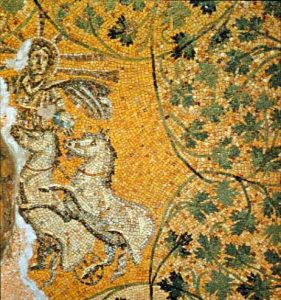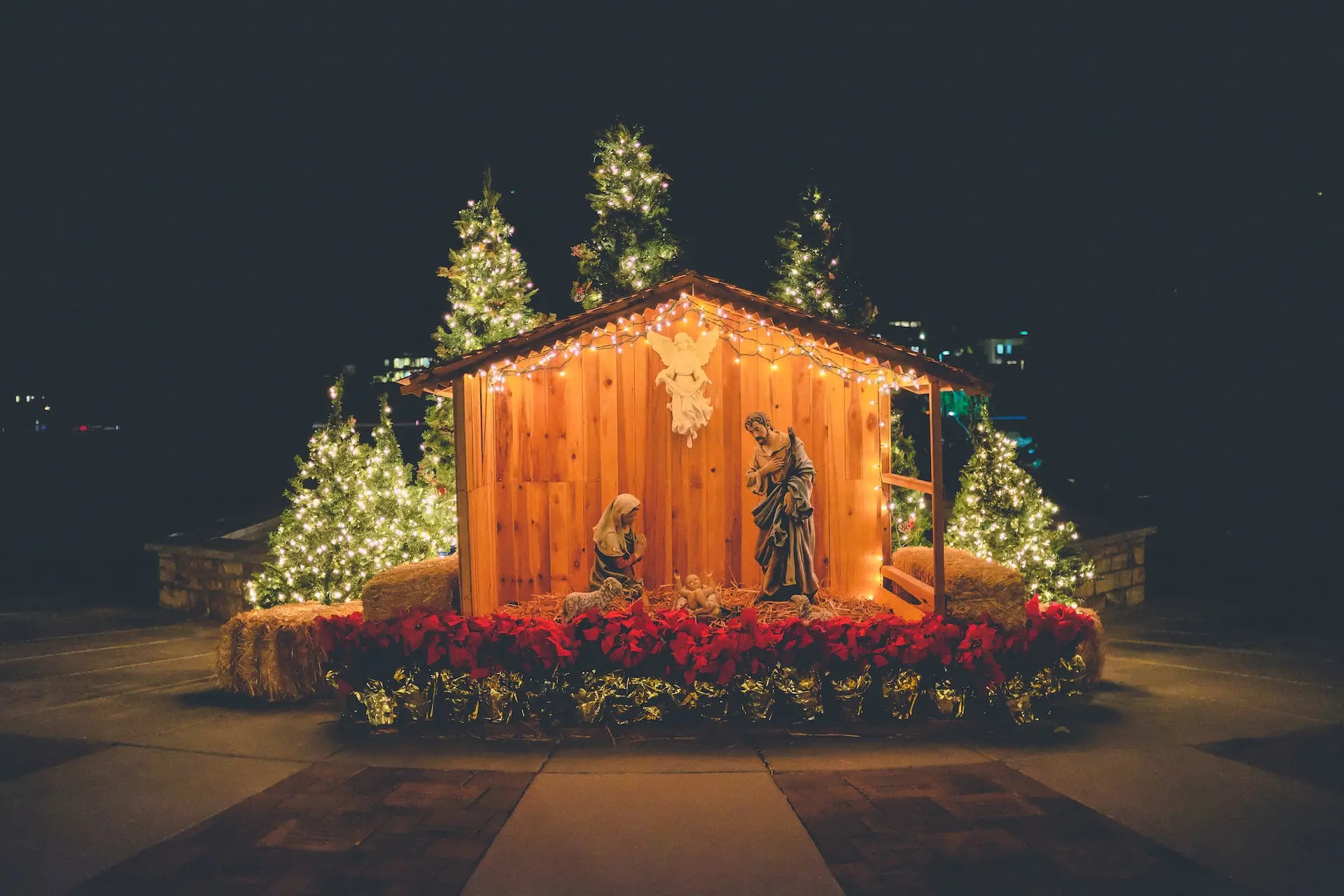Every year at Christmas time we hear arguments that our Christmas celebrations are little more than warmed over paganism. We hear that the date was selected to compete with pagan holidays, or worse, to absorb pagan holidays into the church, and that our Christmas practices originate in paganism. What are we to make of these arguments? Are we buying into paganism in our Christmas celebrations?
The answer is no. The arguments for the supposed pagan origins of Christmas are overblown, and even where there are some tinges of pagan roots in our practices, that doesn’t mean we are practicing paganism. We’ll look at two specific examples in this article, the date of Christmas, and Christmas trees and related customs.
The Dating of Christmas
When talking about the date of Christmas, people routinely tell you that we do not know when Jesus was born, but we celebrate Christmas in December because the church wanted to compete with the popular pagan Roman holiday of Saturnalia. The “Jesus Myth” theory, which says that Jesus never actually lived but that his story was stolen from paganism, takes this argument one step further.
It argues that along with Saturnalia, December 25 was the date of the birth of Horus, Mithras, Sol Invictus (the Unconquered Sun), and a host of other dying and rising deities; Jesus mythicists also claim that all of these gods were born of a virgin with a birth attended by three wise men, had twelve followers, etc., demonstrating that the church stole these stories as it invented the life of Jesus.
This is all nonsense.
The “Birth” of Pagan Gods
On its most basic level, none of these gods were born in historical time. In every case, the birth and life occurred in what can best be termed mythological time. While the birth of certain gods is connected to human kings or royalty, these people are themselves legendary and exist outside of history. Jesus’ birth is radically different in that it occurred in historical time, in an identifiable place, with confirmable historical figures attached to it.
Even on their own terms, however, neither the Saturnalia theory nor the Jesus Myth makes sense of the existing evidence.
Saturnalia ran from December 17–23. This is close to December 25, but not the same, so it’s hard to argue that Christmas was a baptized version of that celebration.
Contrary to what is commonly claimed, Horus’s birth was celebrated in late August, not December, and his mother Isis was married to Osiris and was not a virgin. Similarly, there is no evidence that December 25 was Mithras’s birthday, and he was not born of a virgin; he was born of a rock (though I suppose we could assume the rock was a virgin). In neither case were there wise men, nor twelve disciples, nor any of the other alleged parallels.
The birthday of Sol Invictus seems to have been celebrated on December 25, but the earliest source for this date comes from a calendar from the year 354, and even here the evidence is ambiguous. This means that the first evidence we have of the feast of Sol Invictus being celebrated on December 25 comes from decades after that date had been adopted by the church in Rome for the celebration of Christmas.
If anything, this suggests that the feast of Sol Invictus was an attempt to paganize a Christian holiday rather than the other way around. (The same is true for our sources for Mithras worship: they all post-date Constantine’s conversion and the dating of Christmas, so whatever influence there was most likely flowed from Christianity to Mithras worship rather than from Mithras worship to Christianity.)
Although a few early Christian writers noted a connection between the solstice and Jesus’ birth, none make any connection to pagan myths, which is surprising if that was the point of the date. In fact, the idea that our date for Christmas was influenced by pagan festivals only appears in the twelfth century, eight centuries after the date was set. No contemporary evidence suggests that Saturnalia or the birth of sun gods had anything to do with Jesus’ birth.
None of these alleged sources for Christmas bear any scholarly weight. So where does the date of our Christmas celebration come from?
Jesus’ Birth and Christmas

“The Adoration of the Shepherds” by Andrea Mantegna (1431–1506), Public Domain
The early church didn’t celebrate Jesus’ birth, and until the late third century there was no real interest in the date. (This by itself should put the lie to the idea that Jesus is nothing more than a borrowed sun deity—if he was, you’d expect the date to be established very early.) In the third century, some church leaders began trying to figure out the date of his birth, with May 20 being a popular choice. In the mid-fourth century, either December 25 in the West or January 6 in the East emerged as the consensus dates for celebrating Jesus’ birth.
So how did they come up with those dates?
The date of Christmas is connected to the date of Good Friday. Jesus died on 14 Nisan in the Jewish lunar calendar; the second-century church father Tertullian converted this to March 25 in the Roman solar calendar. An anonymous fourth century treatise argues that Jesus entered the world (i.e. was conceived) on the same day that he died; the feast of the Annunciation was thus set to March 25, which made the date for his birth December 25.1
In the East, the Crucifixion was dated not to 14 Nisan but to 14 Artemisios, the first month of Spring on their local Calendar. In the Roman calendar, this is April 6, which then became the feast of the Annunciation in the East. This led to Christmas being celebrated nine months later on January 6.
The idea that there is a connection between Jesus’ conception and death probably came from Jewish thought. In the second century, at least some Jewish rabbis believed that important events occurred in the same month. Thus Rabbi Eliezar argued, “In Nisan the world was created; in Nisan the Patriarchs were born; on Passover Isaac was born … and in Nisan [our ancestors] will be redeemed in the world to come.” This thinking seems to have informed early Christian theologians as they pondered the relationship between Jesus’ birth and death.
Correlation does not mean causation: just because Jesus’ birth was celebrated at approximately the same date as pagan festivals does not mean that there is a connection between the two, especially since there is no evidence of such a connection in the historic sources.
The Jewish background to Christianity and the connection with the Crucifixion is a much better explanation for both of the dates when Christmas was celebrated than any supposed connection to paganism.
Christmas Trees
We also see the argument that Christmas trees are a remnant of the pagan past. Some sources (of questionable historical value) claim they go back to ancient Egypt, others to ancient Babylon, still others to Celtic, Roman or Norse paganism. Some even cite Jeremiah 10:2–5 as an explicit condemnation of Christmas trees.
Christmas Trees and the Bible
Let’s deal with Jeremiah first. Modern translations indicate that what is being discussed here is cutting down a tree in the forest, shaping it with a tool (a chisel or axe), and covering it with gold and silver to make an idol. If there’s any question in your mind about this, I suggest you read the verses in context.
Vs. 5 and 8–9 indicate that we are dealing with an idol, and that it is wearing purple clothing, not simply draped with gold and silver ornaments. So no, it isn’t a Christmas tree, and the only way to make it one is to force Christmas trees into a few selected verses taken out of context and using the King James translation since more modern translations won’t support the argument.
So Jeremiah is irrelevant, but what about the idea that Christmas trees come from paganism? People who cite Egypt as a source argue that the Egyptians worshiped palm trees, and they point out that Druids worshiped oaks; they then conflate these with Christmas trees, even though neither are evergreens. And this is supposed to be evidence?
Christmas Trees in Pagan Culture
On the other hand, the ancient Romans did use evergreen wreaths to celebrate Saturnalia, and for that reason the early church did not use wreaths or evergreens as decorations. Likewise Yule logs were a pagan custom intended to call back the sun on the Winter solstice, and holly and ivy were pagan symbols of fertility.

Illustration of an ancient Nordic Yule festival (Die Gartenlaube, 1880), Public Domain, via Wikimedia Commons
The pagan custom of using evergreens as winter decorations continued to be practiced in Scandinavia even after the region converted to Christianity, though the symbolism was reframed in Christian terms as a symbol of eternal life (more on that below).
None of this has anything to do with Christmas trees, however.
Christmas Trees in Medieval Christianity
The earliest Christmas trees date to the mid- to late-1400s or early 1500s AD in Germany and German towns in the Baltic (not Scandinavia). That’s about 700 years after the region had converted to Christianity from paganism.
The most likely source of the Christmas Tree is the “Paradise Tree” from medieval mystery plays dealing with the Fall of Adam and Eve in the Garden. These trees were decorated with apples (later changed to balls) to symbolize the fruit of the Tree of the Knowledge of Good and Evil, as well as wafers to represent the Eucharist. They were placed in people’s houses and were closely associated with the Christmas season since the name day of Adam and Eve was celebrated on December 24 in many countries.
So the origin of Christmas trees is found in medieval and early modern Christianity, not in paganism, which had not been practiced in the region for many centuries.
Contextualizing the Gospel
But we need to address another question here: what about those practices that do have pagan roots, such as Yule logs, wreaths, and holly? Should Christians avoid them, even if for us they symbolize something totally different—eternal life through Christ—than what they symbolized for the pagans who originated the practices?

An image of a mid-third century ceiling mosaic depicting Christ as Sol Invictus. The image was found in a Christian tomb and shows how early Christian art adapted imagery and symbols already known in the culture. Leinad-Z, Public domain, via Wikimedia Commons
Missiologists today emphasize the need to contextualize the Gospel, that is, to find elements in the culture that are there by common grace that provide an entry point for the Gospel, and to encourage a culturally appropriate form of Christianity rather than reproduce Western models of the church. After all, we want to spread the Gospel, not Western culture.
So here’s the question: if that’s good enough to spread the Gospel to unreached people today, why don’t we think it was appropriate when Christian missionaries did precisely the same thing: taking elements of pagan culture and reinterpreting them to provide an entry point for the Gospel to our pagan ancestors? Why are we so shocked and appalled at ostensible pagan elements that have been reinterpreted in our Christianity, but have no problem when missionaries do parallel things in other cultures? Why do we insist our Christianity be “pure,” but not the Christianity spreading among newly reached peoples?
Conclusion
Whatever elements of paganism may have crept into our Christmas celebrations, they were culturally appropriate and necessary in their day, and have been thoroughly baptized, reinterpreted, and Christianized. We have no reason to get hung up by “pagan Christianity,” especially in the Christmas season where the pagan roots of our practices have been greatly exaggerated. The rampant consumerism of our age is a different matter, but that’s a result of our own greed rather than paganism from millennia ago.
Notes:
1. Interestingly, Frederick Larson makes a case on the basis of astronomical evidence that December 25 may have been the date the Magi arrived in Jerusalem in his DVD The Star of Bethlehem (cf. his website, http://www.bethlehemstar.net/starry-dance/to-stop-a-star/). Even if this is correct, however, it has nothing to do with the dating of Christmas.
You may also like:



